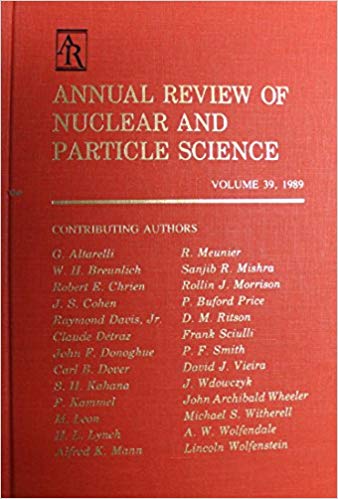核子形态因子的格点QCD测定现状及其与少数GeV中微子程序的相关性
IF 9.1
2区 物理与天体物理
Q1 PHYSICS, NUCLEAR
Annual Review of Nuclear and Particle Science
Pub Date : 2022-01-05
DOI:10.1146/annurev-nucl-010622-120608
引用次数: 18
摘要
中微子-核截面的计算从中微子-核子相互作用开始,使得后者对旗舰中微子振荡实验至关重要,尽管测量有限,统计数据不佳。另外,晶格量子色动力学(LQCD)可以用来确定这些相互作用的标准模型与可量化的理论不确定性。最近gA的LQCD结果与数据非常吻合,并且具有完全不确定性预算的(准)弹性核子形状因子的结果有望在几年内得到。我们回顾了核轴形因子FA(Q2)的场状态和LQCD结果,FA(Q2)是模拟亚gev中微子-核子相互作用的主要不确定性来源。不同LQCD计算的结果是一致的,但总体上与现有模型不一致,这对当前和未来的中微子振荡实验有潜在的影响。我们描述了一个路线图,以巩固对LQCD结果的信心,并讨论了未来更复杂过程的计算,这对少数gev中微子振荡实验很重要。《核与粒子科学年度评论》第72卷的最终在线出版日期预计为2022年9月。修订后的估计数请参阅http://www.annualreviews.org/page/journal/pubdates。本文章由计算机程序翻译,如有差异,请以英文原文为准。
Status of Lattice QCD Determination of Nucleon Form Factors and Their Relevance for the Few-GeV Neutrino Program
Calculations of neutrino–nucleus cross sections begin with the neutrino–nucleon interaction, making the latter critically important to flagship neutrino oscillation experiments despite limited measurements with poor statistics. Alternatively, lattice quantum chromodynamics (LQCD) can be used to determine these interactions from the Standard Model with quantifiable theoretical uncertainties. Recent LQCD results of gA are in excellent agreement with data, and results for the (quasi-)elastic nucleon form factors with full uncertainty budgets are expected within a few years. We review the status of the field and LQCD results for the nucleon axial form factor, FA( Q2), a major source of uncertainty in modeling sub-GeV neutrino–nucleon interactions. Results from different LQCD calculations are consistent but collectively disagree with existing models, with potential implications for current and future neutrino oscillation experiments. We describe a road map to solidify confidence in the LQCD results and discuss future calculations of more complicated processes, which are important to few-GeV neutrino oscillation experiments. Expected final online publication date for the Annual Review of Nuclear and Particle Science, Volume 72 is September 2022. Please see http://www.annualreviews.org/page/journal/pubdates for revised estimates.
求助全文
通过发布文献求助,成功后即可免费获取论文全文。
去求助
来源期刊
CiteScore
21.50
自引率
0.80%
发文量
18
期刊介绍:
The Annual Review of Nuclear and Particle Science is a publication that has been available since 1952. It focuses on various aspects of nuclear and particle science, including both theoretical and experimental developments. The journal covers topics such as nuclear structure, heavy ion interactions, oscillations observed in solar and atmospheric neutrinos, the physics of heavy quarks, the impact of particle and nuclear physics on astroparticle physics, and recent advancements in accelerator design and instrumentation.
One significant recent change in the journal is the conversion of its current volume from gated to open access. This conversion was made possible through Annual Reviews' Subscribe to Open program. As a result, all articles published in the current volume are now freely available to the public under a CC BY license. This change allows for greater accessibility and dissemination of research in the field of nuclear and particle science.

 求助内容:
求助内容: 应助结果提醒方式:
应助结果提醒方式:


